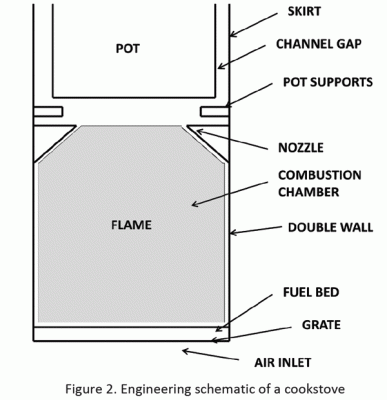Marc Pare, June, 2010
Three friends and I spent last semester at Georgia Tech working on the thermodynamic modeling (and optimization) of cook stoves... I attached a summary of our project and the meat of the analysis section and the Full Report (see the attachments)

TOWARD END-TO-END IMPROVED COOK STOVE OPTIMIZATION
By Marc-Antoine Paré, Matt Redmond, Christopher Beebe, and Nick Kretschmar
While it is possible to build and test the performance of prototype Improved Cook
Stoves without significant capital investment, if the amount of time that it takes to
optimize candidate stove designs could be drastically reduced, then cook stove
technology could reach the hands of many more in developing nations. It was identified
that an end-to-end modeling and optimization effort for Improved Cook Stove (ICS)
design could aid in the development of more efficient and cleaner-burning stoves. The
thermodynamic and heat transfer processes underlying cook stove performance are
tightly coupled, which makes modeling a challenge. The following analysis is a first
attempt at capturing each of the underlying processes of stove performance. The model is
formulated so as to facilitate the optimization of stove geometry. This effort helps
pinpoint the deficiencies of the current state of stove modeling and attempts to
demonstrate the eventual power of a predictive stove model.
A rocket stove was chosen as the target for modeling. The major thermodynamic,
fluid mechanic, and heat transfer processes were identified. Analytical expressions based
on the fundamentals of heat transfer as well as experimental correlations were written.
Finally, numerical techniques were applied to design a stove with an optimal
thermodynamic efficiency. Samuel Baldwin's work on the engineering design of cook
stoves was used as a primary source, but it was augmented by a number of more modern
articles.
As a proof of concept for the usefulness of a cook stove simulation, a novel
design combining a skirted rocket stove and an interior nozzle was optimized. The
resulting model suggested that an interior nozzle was not desirable since it contributed a
large pressure drop that lowered overall convective heat transfer. Three major geometric
parameters: gap size, pot height, and stove diameter were optimized for overall stove
efficiency, as well.
Unfortunately, the model presented in this report is not quantitatively predictive
of actual stove performance. The effort of attempting to capture all of the coupled
processes related to stove performance serves to pinpoint the areas ripe for future work.
For instance, predicting combustion characteristics for improved cook stoves proved to
be out of reach for a model based on analytical expressions. However, convective and
radiative heat transfer processes were captured relatively completely. Another area of
improvement would be in the interface to interacting with the model. For now, the
implementation was performed in MATLAB, which makes modification error-prone
(though relatively quick in the hands of someone familiar with the model). The ultimate
vision of this project is a flexible stove modeling application that allows relief workers in
developing nations to generate optimal stove designs based on local materials and
cooking habits. Over the course of the design project, groups looking to deploy stove
technology in relief efforts approached the team on three separate occasions; there is
significant interest in ICS deployment, and modeling could help turn that interest into
effective action.
Read the the meat of the analysis section (pdf).
Regards,
Marc Paré
Mechanical Engineering
System Realization Laboratory
Georgia Institute of Technology | Université de Technologie de Compiègne
my cv, etc. | http://www.prism.gatech.edu/~mpare3/index.htmlsneakers
